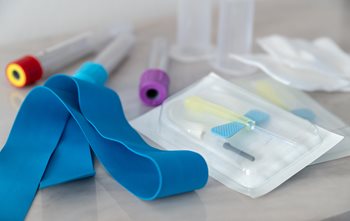
Effective Blood Collection - Phlebotomy
Phlebotomy, or bloodletting as it was originally called, is the art of blood collection, and dates back to well before the 5th century B.C. It was used as a form of battling sickness. It was believed that the draining of some of a person’s “bad” blood, generally 1-4 pints, would allow them to be healed from whatever was ailing them. An interesting side note – our 1st president, George Washington, died as a result of complications from bloodletting. He developed a throat infection after being drained of nearly 9 pints of blood!
The phlebotomy procedure is performed by many healthcare professionals, with many facilities and institutions requiring nurses to perform this important function. Due to the lack and or inconsistency of phlebotomy basics in nursing curricula, the nurse will find this course beneficial. In all 50 states, an RN, LPN/LVN, APN, or any other licensed nurse can legally collect blood using their current licensure, and does not need to obtain any additional phlebotomy certification. Additionally, in most states, phlebotomy technicians and medical assistants may not be required to maintain any phlebotomy licensure, but will still need to maintain and enhance their skill set.
Designed to provide education on the different methods of blood collection and the most effective methods to perform blood collection, this course will enable the development of the skills and knowledge needed to confidently perform phlebotomy.
Questions? Check out our FAQs page and How Online IV Certification Works!
The phlebotomy procedure is performed by many healthcare professionals, with many facilities and institutions requiring nurses to perform this important function. Due to the lack and or inconsistency of phlebotomy basics in nursing curricula, the nurse will find this course beneficial. In all 50 states, an RN, LPN/LVN, APN, or any other licensed nurse can legally collect blood using their current licensure, and does not need to obtain any additional phlebotomy certification. Additionally, in most states, phlebotomy technicians and medical assistants may not be required to maintain any phlebotomy licensure, but will still need to maintain and enhance their skill set.
Designed to provide education on the different methods of blood collection and the most effective methods to perform blood collection, this course will enable the development of the skills and knowledge needed to confidently perform phlebotomy.
Questions? Check out our FAQs page and How Online IV Certification Works!
Objectives
Upon completion of this course the user will be able to:
- Distinguish between the different methods of blood collection.
- Understand which method to choose.
- Properly identify the correct order of draw and understand the difference between the additives in the tubes.
- Know the meaning of an anti-coagulant.
- Identify and correct pre-analytical complications.
- Determine appropriate needle insertion angles and understand the most appropriate and effective methods to use when attempting to locate a vein, and when needing to adjust.
Curriculum
Chapter 1: Blood Collection Equipment
- Venipuncture Equipment
- Tubes and Additives
- Syringes
- Safety Needles and Holders
- Needles
- Microcollection Equipment
Chapter 2: Venipuncture Procedures
- Standard Precautions
- Preparing for the Patient
- Patient Identification
- Patient Interaction
- Vein Selection
- Preparing the Site
- Performing Venipuncture
- Procedure Completion
- Syringe Method
- Labels
- Patient Prioritization
Chapter 3: Pediatric and Geriatric Procedures
- Pediatric Blood Collection
- Psychology
- Pediatric Phlebotomy Procedures
- Heel stick Procedure
- Neonatal Screening
- Pediatric Venipuncture
- Geriatric Patients
Chapter 4: Pre-Analytical Complications in Blood Collection
- Patient Complications Affecting Blood Specimens
- Complications with Test Requests and Identification
- Complications with Specimen Collection Procedures
- California Bill 241
- Implicit Bias in Healthcare
- What is Implicit Bias?
- Implications of Implicit Bias in Healthcare
- How to Reduce Implicit Bias
Price: $36.00
Contact Hours: 3

Course Author

Souraya Ballew
Souraya is a Registered and Certified Phlebotomy Technician who brings forth 27 years of experience.
Read Full BioCourse Accreditation
See our Accreditation Statements page to view our accreditation information.